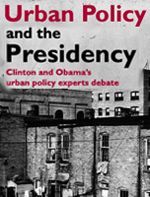Understandably, Senators Clinton and Obama were a touch busy last week, so they sent campaign surrogates to the University of Pennsylvania’s “Urban Policy and the Presidency” debate to elaborate on their urban policy agendas. For Clinton, James Eisenhower stood in. Eisenhower is an attorney with Schnader, Harris, Segal, and Lewis LLP in Philadelphia, and serves on Governor Rendell’s Intergovernmental Cooperation Authority. Obama sent two representatives. Robert Weissbourd worked at the innovative Shorebank Corproration in Chicago for a decade, and is the Chair of Obama’s “Urban Policy Group.” Andrew Lamas also stood in for Obama. Lamas teaches in the Urban Studies Program at Penn, and serves on the board of the Bread and Roses Community Fund. Gideon Parchomovsky of Penn Law moderated.
After brief opening statements, the conversation turned to questions on a variety of topics: affordable housing, homeownership, economic development, and transit. As has been pointed out so many times in this campaign, one would be hard pressed to see much daylight between the policies of these two candidates. On affordable housing, both believe that the Section 8 and Hope 6 programs must be better funded, and that HUD must be revitalized. Considering the current corruption scandals at HUD, this may actually provide a campaign talking point in the fall. Though one wonders if the talking point will be made about the need for enhanced federal funding for housing programs, or for a more general “anti-Bush-corruption” renewal.
On homeownership, both candidates stressed that working people should be enabled to enter the housing market. Andrew Lamas argued that “if we want poor working people to have assets, those assets are in their homes.” Eisenhower pointed out that Clinton wants to increase federal mortgage funding, and that the federal government must be aggressive in sorting out the current foreclosure crisis. Again, no real disagreements there.
When the topic turned to economic development we finally saw a slight variation in policy prescriptions. Obama is pushing a regional planning model, granting as much autonomy as possible to the different constituencies in the region, down to the neighborhood level. Allowing for individual neighborhoods to tailor their own solutions, or “customized intervention,” grows from Obama’s much-heralded experience as a community organizer on the south side of Chicago. Growing “human capital” was touted as Obama’s true strategy to revitalize urban economies, which will of course involve funding education, entrepreneurship training, and small business loans. While Clinton’s policy solutions here—block grants, the COPS program to reduce crime, green investment—were many, there was no overall vision of how neighborhoods might tackle their problems from the ground up, rather than waiting for the hand down from Washington.
Both candidates are eager to fund regional rail networks, but again Obama seems to have at least attended a couple of planning seminars—as Weissbourd emphasized his intention to demand “smart growth” principles be worked into regional transportation planning. Seemingly, this means that environmental justice and sustainable land-use would be checked off before an Obama transportation bill would be signed.
Minimum wage, education, eminent domain, and gentrification were also discussed, with no great differences between Clinton and Obama, and nothing surprising or particularly innovative presented, though to be fair the clock was ticking down by this point in the session.
A compelling question about how the candidates will “fill the gap between the city and the state” was raised from the floor. Eisenhower, for Clinton, suggested that we need to convince people that the problems of smaller cities and those of the metropolis aren’t really that different. Reaching out to the young mayors in the state might be a way to build a common urban agenda in the state. Whether or not such an assertion is true, it strikes me that this is a canny political strategy—what a President can do to foster it, though, is a mystery to me. Weissbourd, for Obama, rehearsed what he sees as Obama’s unique approach: a regional view that will integrate the urban and suburban policy process. He went on to suggest an administrative unit would be created under Obama, an “Urban Policy Office,” intended apparently to negotiate the difficulties of urban/suburban/rural policy coordination. Issues of environmental justice and crime prevention were also raised from the floor, but by this point the crowd had grown restless and the session was clearly winding down.
I was left wondering where Philadelphia, specifically, might fit into this conversation. What about getting guns off the street, brownfield remediation, disaster and emergency management in a post-industrial city? What about funding for the arts, medical research, and higher education—the growing sectors of the local economy? These issues were left unquestioned—waiting for the return of the nominee. Considering the importance of Pennsylvania on the electoral map, we will no-doubt enjoy the chance to follow up on these questions in October.
















